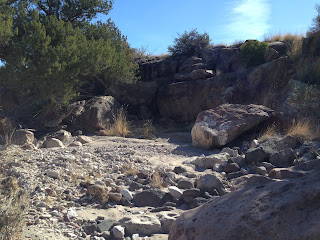Sixmile Canyon, Magdalena Mountains- Cibola National Forest
I had wanted to do a hike on our return trip from Albuquerque. Something that wasn't too far off I-25. At first I thought of returning to East Red Canyon and continuing into its tributary slot, Deep Canyon, which I've been itching to see since last summer's visit to East Red's slot (box) section. I also briefly entertained the idea of a hike either off of the Quebradas Backcountry Byway, or on the Chupadera Trail that leaves out the Bosque del Apache. The weather was going to be just a bit too warm for either one of those. Then it occurred to me that I have never really done a hike in the Magdalena Mountains, save for some wandering around old mines the morning after doing some dispersed camping off of the Water Canyon Road around 30 years ago.
I decided on Sixmile Canyon, the closest forest trail to Socorro. The directions seemed simple enough. Find Forest Road 38 off of US 60, drive to where you can't drive anymore, and then start hiking. If I had done just a little more research, I might have saved us a lot time and energy. First, finding FR 38 didn't happen. All we found was FR 38A , so we drove a little further west only to find FR 37( which leads to South Canyon, which was another hiking option) with its ominous " Primitive Road" sign, something my wife surely doesn't enjoy seeing right at the outset. So we returned to 38A with the idea that it would surely lead us to FR 38. It did and it didn't.Two times. We eventually got to a parking place on the mesa overlooking Sixmile Canyon on its west side. The"road" had been two bumpy, red gravel tracks in the grass. There had been much discussion and we had gone through the same difficult to close gate twice. We never saw another of those little brown masonite road number signs that the forest service uses, or even a sign to indicate if we were on forest service land( as it turned out we started on a section of state land).
Second problem. We could see the canyon and what surely was FR 38 in its bottom. We just couldn't get to it all that easily. My wife is not a big fan of rocky, slippery, steep, trail-less descents. I'm not either, but will do it for expediency's sake when I'm alone. So, we found the cow trail that led through two side gullies, up on another mesa where we lost it briefly only to find it and have it take us down hill quite steeply in its own rocky and slippery way.
Now my planned hike could actually begin, sort of. I would have liked to have driven further down the road we were now walking on so I could spent most of my hiking time in the narrower, more forested section of the canyon. As it was, this part of Sixmile Canyon was open, dusty and hot. Live oaks, junipers and piñons looked parched and stunted. The deciduous oaks and walnut trees had yet to even bud.


I hadn't worn my big hat, because of the predicted high winds that day, so I knew I was working on a good sunburn. My wife had the wrong socks (she would get at bad blister on one foot by the end of the day). And we hadn't even thought to bring any lunch. It was getting to feel like a trudge as we ambled over a fan of boulders brought down by flooding side canyon and past a very faint old road that went up onto the mesa. The narrower reaches of the canyon were visible ahead but didn't seem to be getting nearer. Finally, after about a mile and a half the walls closed in enough to provide shade. Fire smoke stained the rock walls in shallow shelters created by the seasonal flow of the now dry stream. I was relieved now to be in the more sheltered environment.

Ponderosa pines appeared in the valley and sparse Douglas firs grew on the margins of the many rock glaciers on the hillsides. Dried grass, thick along the flanks of streambed, was an obvious indicator that green grass grows very nicely here in the summer monsoon.



In just another half mile or so we opened a wire gate and entered a little slot canyon. Once again there were blackened ceilings of shallow alcoves. A rusty pipe peeking out from the gravel, and and old wooden watering trough, that I only noticed on the way back out told me this was the location of Box Spring ("Box" referring to the little slot canyon). Still there was no surface water flowing, although the spring could still be seeping under all that gravel.



Upstream of the box, the two track now became a rustic single path through riparian forest habitat. The maps I had indicated there were more springs upstream but no water burbled or trickled in the creek. I wished I could've gone on, but time was now short and hunger would soon be factor. We turned around.
Driving back towards Socorro on US 60, I finally made visual contact with the entrance to FR 38, much further back toward town than I had guessed it would be. When I got back to my maps later that day, I made sense of the whole road situation that had us so confused. It would be a beautiful place to come back to, say in the fall with oaks and walnut turning, but this time with more information and better prepared.
Labels: hiking





















































